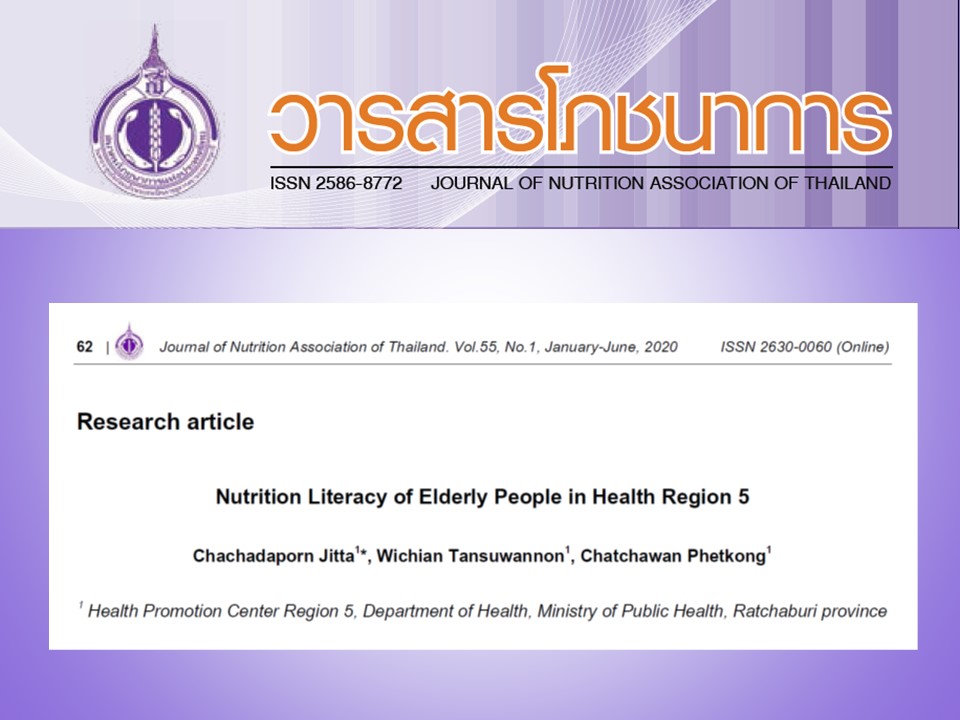Nutrition Literacy of Elderly People in Health Region 5
Keywords:
Nutrition literacy, Elderly people, Body mass index, Non-communicable diseasesAbstract
This study aimed to investigate nutrition literacy and the association between personal factors and nutrition literacy among elderly people who participated in the ‘Quality elderly club’ in Health Region 5. Three hundred and nine elderly people recruited from the quality elderly club were purposively selected for a cross-sectional descriptive study. Weight, height, and waist circumference were measured in all participants. Body mass index (BMI) and waist circumference were used to define the nutritional status of the elderly. The nutrition literacy level of participants was examined using a validated nutrition literacy questionnaire. Results: 46.6 and 45.3% of the participants had moderate and low nutrition literacy levels, respectively. Using simple correlation, individual factors that were significantly associated with nutrition literacy were: age (p<0.05), an education level (p<0.01), reading and writing ability (p<0.01). Participants who had normal nutritional status had significantly lower scores in interactive nutrition literacy than overweight and obese participants. There was no difference between the nutritional status of any other literacy scores. Accessibility to media significantly associated with nutrition literacy, using simple correlation, were: print media (p<0.01), internet (p<0.01), and line group (p<0.01). The finding from the present study could be beneficial for developing nutrition media, selecting media channels, and designing the learning process to increase nutrition literacy among the elderly for adequate nutrient intakes and preventing risks of non-communicable diseases (NCDs).
References
ศูนย์เทคโนโลยีสารสนเทศและการสื่อสาร. ข้อมูลประชากร ประมวลผลจากโปรแกรม HDC. [อินเทอร์เน็ต].สำนักงานปลัดกระทรวงสาธารณสุข 2562; [เข้าถึง เมื่อ 10 ก.ย. 2562]. เข้าถึงได้จาก: https://hdcservice.moph.go.th/hdc/reports/page.php?cat_id=ac4eed1bddb23d6130746d62d2538fd0
สํานักพัฒนานโยบายสุขภาพระหว่างประเทศ. รายงานภาระโรคและการบาดเจ็บของประชากรไทยพ.ศ.2557. นนทบุรี: เดอะ กราฟิโก ซิสเต็มส์ จำกัด; 2560.
Nutbeam, D. Health Literacy as a public health goal. A challenge for contemporary health education and communication strategies into health 21st century. Health Promotion International. Great Britain; 2000.
Nutbeam, D. Health Literacy and adolescents: a framework and agenda for future research. Health Education Research. Oxford University Press; 2008.
World Health Organization. Health literacy and health behavior [December 9, 2010.].
Available from: http://www.who.int/healthpromotion/conferences/7gchp/track2/en/.
U.S. Department of Health and Human Services OoDPaHP. National Action Plan to Improve Health Literacy. Washington, DC: Author; 2010.
Rootman I, Ronson B. Literacy and health research in Canada: where have we been and where should we go? Can J Public Health. 2005; 96(Suppl 2):S62-77.
Statistics ABo. Health Literacy, Australia. Canberra: National Information and Referral Service; 2006.
คณะกรรมการดำเนินงานจัดทำแผนพัฒนาสุขภาพแห่งชาติ ฉบับที่ 12. แผนพัฒนา
สุขภาพแห่งชาติ ฉบับที่ 12 (พ.ศ.2560-2564). นนทบุรี: กระทรวงสาธารณสุข; 2559.
กรมอนามัย กระทรวงสาธารณสุข. แนวทางการพัฒนาโรงเรียนรอบรู้ด้านสุขภาพ 2563; 1-34.
Silk KJ, Sherry J, Winn B, Keesecker N, Horodynski MA, Sayir A. Increasing nutrition literacy: testing the effectiveness of print, web site, and game modalities. J Nutr Educ Behav. 2008; 40:3–10.
Carbone, E.T., & Gibbs, H.D. Measuring nutrition literacy: Problems and potential solutions. J Nutr Disord Ther. 2013; 3:e105.
Krejcie, R. V., and Morgan, D. W. Determining sample size for research activities. Educ Psychol Meas. 1970; 30:607–610.
กรมอนามัย กระทรวงสาธารณสุข. แนวทางการพัฒนาโรงเรียนรอบรู้ด้านสุขภาพ 2563; 1-34.
กรมการแพทย์ กระทรวงสาธารณสุข.คู่มือการคัดกรอง/ประเมินผู้สูงอายุ.นนทบุรี: สำนักงานกิจการโรงพิมพ์องค์การสงเคราะห์ทหารผ่านศึก; 2557.
วิมล โรมา, ชะนวนทอง ธนสุกาญจน์, มธุรส ทิพยมงคลกุล, ณัฐนารี เอมยงค์, นรีมาลย์ นีละไพจิตร, มุกดา สำนวนกลางและคณะ. โครงการสำรวจความรอบรู้ด้านสุขภาพของประชาชนไทย อายุ 15 ปี ขึ้นไป พ.ศ. 2560 (ระยะที่ 1). สำนักงานโครงการขับเคลื่อนกรมอนามัย 4.0 กรมอนามัย; 2561.
วรรณศิริ นิลเนตร. ความฉลาดทางสุขภาพของผู้สูงอายุไทยในชมรมผู้สูงอายุในเขตกรุงเทพมหานคร [วิทยานิพนธ์ปริญญาวิทยาศาสตร์ดุษฎีบัณฑิต]. กรุงเทพฯ: จุฬาลงกรณ์มหาวิทยาลัย; 2557.
เยาวลักษณ์ มีบุญมาก, จิริยา อินทนา, กรรณิการ์ กิจนพเกียรติ, เพ็ญจมาศ คาธนะ, นงณภัทร รุ่งเนย. ความรอบรู้ด้านสุขภาพของผู้สูงอายุในชุมชนกึ่งเมืองแห่งหนึ่งในจังหวัดราชบุรี 2562. วารสารเครือข่ายวิทยาลัยพยาบาลและการสาธารณสุขภาคใต้ 2562; 6 (ฉบับพิเศษ): 129-141.
อังธนา จุลสุคนธ์, นพวรรณ เปียซื่อ, วราภรณ์ ทิพย์สุวรรณกุล, จิราพร ไลนิงเกอร์. ความรอบรู้ด้านโภชนาการและผลลัพธ์ทางสุขภาพของผู้สูงอายุที่เป็นเบาหวานชนิดที่ 2. วารสารสภาการพยาบาล. 2562; 34 (4),120-135.
Oreonez TN, Yassuda MS, Cachioni M. Elderly online: effects of a digital inclusion program in cognitive performance. Arch Gerontol Geriatr. 2011 [cited 2011 Oct 20]; Sep-Oct;53(2):216-9. Available from: https://www.sciencedirect.com/science/article/abs/pii/S0167494310002852
ศูนย์อนามัยที่ 5 กรมอนามัย กระทรวงสาธารณสุข. หลักสูตรโรงเรียนผู้สูงอายุ เขตสุขภาพที่ 5. ศูนย์ อนามัยที่ 5 ราชบุรี; 2559.
นฤมล ใจดี, รัฐฐา ระมั่ง, นวลจันทร์ กวินวาณิช, ราตรี โพธิ์ระวัช. ความฉลาดด้านสุขภาพของผู้สูงอายุในอำเภอเมือง จังหวัดกำแพงเพชร. รายงานสืบเนื่องจากการประชุมวิชาการระดับชาติ ครั้งที่ 6.กำแพงเพชร:สถาบันวิจัยและพัฒนา มหาวิทยาลัยราชภัฏกำแพงเพชร; 20 ธันวาคม 2562: 1312-1323.

Downloads
Published
How to Cite
Issue
Section
License
Upon acceptance of an article, copyright is belonging to the Nutrition Association of Thailand.


